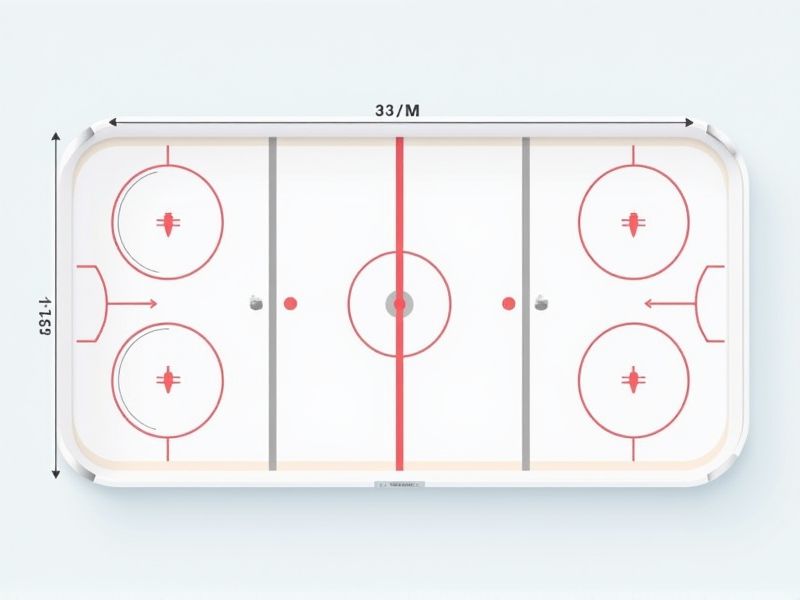
A standard ice hockey rink used in the NHL is 200 feet long and 85 feet wide, with rounded corners for better puck movement. International rinks, commonly used in Olympic play, are slightly larger at 197 feet long by 98.5 feet wide. The rink is divided by a center red line and two blue lines that create three zones: defensive, neutral, and offensive. Being aware of these dimensions helps players and coaches strategize positioning, while fans can better understand the flow of the game.
Length: 200 Feet
A standard hockey rink measures 200 feet in length, making it essential for gameplay dynamics. The width of the rink is typically 85 feet, providing ample space for teams to maneuver. Along the perimeter, the boards are 42 inches high, designed to contain the puck and maintain game flow. Understanding these dimensions can enhance your appreciation for player strategies and the game's intricate pace.
Width: 85 Feet
The standard width of a hockey rink measures 85 feet, providing a spacious environment for players to maneuver and strategize during games. This regulation width allows for optimal gameplay dynamics, accommodating fast-paced action and strategic plays. The overall dimensions, paired with the length of 200 feet, create an ice surface totaling 17,000 square feet for competition. Maintaining these dimensions is essential for consistency in both amateur and professional leagues worldwide.
Corner Radius: 28 Feet
The standard hockey rink features a corner radius of 28 feet, which is essential for maintaining player safety and facilitating smooth gameplay. This specific radius helps to reduce the risk of injury during high-speed collisions, promoting a safer environment for both amateur and professional players. Moreover, the design allows for better puck movement and enhances overall game dynamics. Understanding these specifications can enrich your appreciation for the sport and its architectural standards.
Blue Line Distance: 64 Feet Apart
The standard hockey rink features blue lines that are precisely 64 feet apart, marking the division between the offensive and defensive zones. This specific distance plays a crucial role in the flow and strategy of the game, influencing player positioning and puck movement. Each blue line is painted in a bold color to ensure visibility for players, referees, and spectators. Understanding this measurement enhances your appreciation for the game's layout and the skills required to navigate these zones effectively.
Goal Line To End Boards: 11 Feet
In ice hockey, the distance from the goal line to the end boards measures 11 feet, creating a critical area for gameplay dynamics. This space affects puck movement and player positioning during offensive and defensive plays. Understanding this measurement is vital for coaches and players, as it impacts strategies during faceoffs and rebounds. Your knowledge of rink dimensions can enhance your appreciation of the game's flow and spatial awareness.
Neutral Zone Length: 50 Feet
The standard length of the neutral zone in a hockey rink measures 50 feet, creating a crucial area for gameplay dynamics. Occupying space between the blue lines, this zone is significant for both offensive and defensive strategies as teams transition between their respective end zones. Understanding the neutral zone's dimensions can enhance your gameplay, allowing for better positioning and seamless puck movement. With a comprehensive grasp of these measurements, players can optimize their performance on the ice and capitalize on scoring opportunities.
Face-Off Circles Diameter: 30 Feet
The standard hockey rink features face-off circles with a diameter of 30 feet, ensuring a regulated area for puck drop situations during games. These circles are crucial for maintaining fair play, allowing players to engage effectively during face-offs. Each face-off circle is positioned 15 feet from the nearest boards, enhancing visibility and ensuring that players are in an optimal position. Understanding the dimensions of the rink can greatly improve your strategic approach to participating in the game.
Goal Crease Radius: 6 Feet
The goal crease in hockey is a critical area, featuring a radius of 6 feet. This zone, marked by a distinct blue line, serves to protect the goalkeeper and regulates player movement during play. Within this 6-foot radius, offensive players face restrictions that prevent them from interfering with the goalie. Understanding this standard ensures that you appreciate the dynamics of strategy and gameplay in hockey.
Center Circle Diameter: 30 Feet
The standard center circle diameter in a hockey rink measures 30 feet, establishing a critical area for face-offs and play initiation. This circle, located at the center of the rink, is essential for maintaining fair competition during the game. In addition to the diameter, the center circle is surrounded by a 10-foot outer circle which further delineates play zones. Understanding these dimensions enhances your appreciation of rink design and player strategy during matches.
Boards Height: 42 Inches
The standard height of hockey rink boards is 42 inches, creating a protective barrier that contains the puck and enhances player safety. This height is regulated by governing bodies like the NHL and IIHF, ensuring uniformity across professional and amateur leagues. Boards at this elevation also facilitate smoother plays, as the puck rebounds off them predictably, maintaining the flow of the game. Understanding the dimensions of your rink can significantly enhance your playing experience, whether you're a recreational player or involved in competitive hockey.
